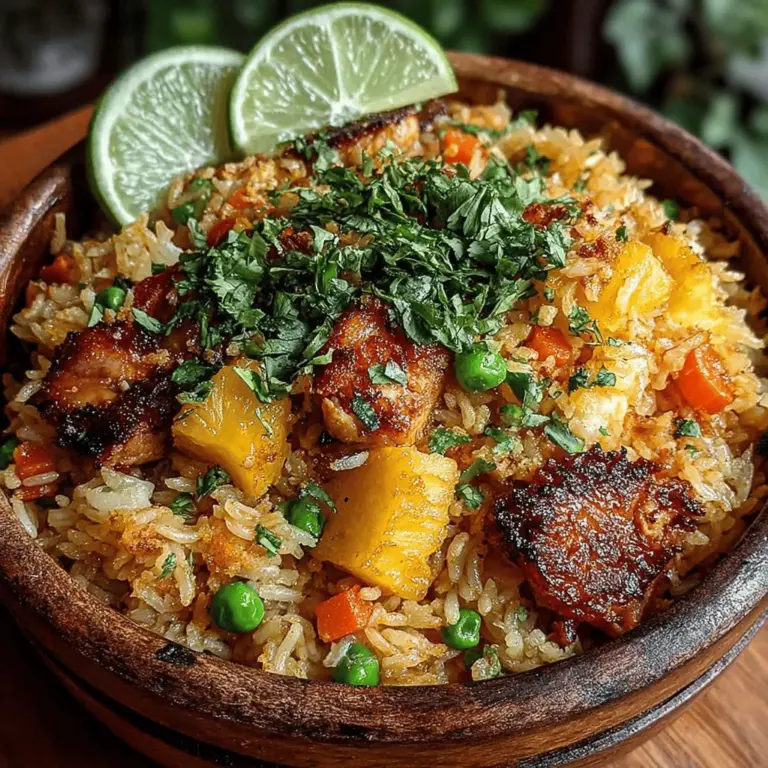Tropical Delight: Pineapple Chicken Fried Rice
Introduction
If you’re looking to transport your taste buds to a tropical paradise, look no further than Pineapple Chicken Fried Rice. This delightful dish marries the sweetness of ripe pineapple with the savory flavors of chicken and vegetables, creating a harmonious blend that is as satisfying as it is colorful. Inspired by Southeast Asian cuisine, this recipe not only offers a burst of flavor but also showcases the importance of using fresh, high-quality ingredients to elevate your meals.
Fried rice is a beloved staple in many cultures, celebrated for its versatility and ability to transform leftover ingredients into a wholesome meal. Whether you’re preparing a quick weeknight dinner or a dish to impress guests, Pineapple Chicken Fried Rice is a perfect choice. It combines protein, vegetables, and grains in one bowl, making it a nutritious and satisfying option that can be easily customized to suit your palate.
Exploring the Ingredients
The beauty of Pineapple Chicken Fried Rice lies in its simple yet vibrant ingredients. Each component plays a crucial role in delivering flavor, texture, and nutrition, making this dish a well-rounded meal. Let’s dive into the key ingredients that make this recipe a tropical delight.
– Cooked Jasmine Rice: The foundation of any fried rice dish is the rice itself, and jasmine rice is the ideal choice due to its fragrant aroma and slightly sticky texture. Its long grains remain fluffy when cooked, which is essential for achieving the perfect fried rice. For optimal results, use day-old rice, as it dries out slightly in the refrigerator, preventing clumping and allowing each grain to fry evenly.
– Cooked Chicken Breast: Chicken breast is a lean protein that adds substance to the dish. It is not only nutritious, providing essential amino acids, but it also absorbs the flavors of the sauces and spices beautifully. For the best results, use cooked chicken breast that has been diced into bite-sized pieces, ensuring it integrates seamlessly with the other ingredients.
– Pineapple: The star of this recipe, pineapple brings a sweet and tangy flavor profile that contrasts beautifully with the savory elements of the dish. Beyond its delicious taste, pineapple is rich in vitamins and minerals, particularly vitamin C and manganese, which can support your immune system and bone health. Using fresh pineapple will enhance the dish’s flavor, but canned pineapple can be a convenient alternative if fresh fruit is unavailable.
– Frozen Peas and Carrots Mix: This mix is a fantastic addition for both convenience and nutrition. Frozen vegetables are often flash-frozen at peak freshness, preserving their nutrients and flavor. Peas are a great source of protein, fiber, and essential vitamins, while carrots add a touch of sweetness and vibrant color.
– Green Onions and Garlic: Aromatics are key to building the dish’s flavor base. Green onions contribute a mild onion flavor and a pop of color, while garlic adds depth and an irresistible aroma. Sautéing these ingredients at the beginning of the cooking process enhances their flavors, setting a delicious tone for the entire dish.
– Soy Sauce and Oyster Sauce: These sauces are traditional flavor enhancers in Asian cuisine. Soy sauce adds saltiness and umami, while oyster sauce brings a rich, slightly sweet depth to the dish. Both sauces work together to create a savory coating that clings to the rice and other ingredients.
– Sesame Oil: A small amount of sesame oil rounds out the flavors with its unique, nutty taste. It also offers potential health benefits, including anti-inflammatory properties and a good source of healthy fats. Drizzling it over the fried rice just before serving adds a fragrant finish that elevates the dish.
For those with dietary restrictions or preferences, there are several ingredient substitutions you can make. For a vegetarian option, consider substituting the chicken with firm tofu or tempeh, which can be marinated and sautéed to achieve a similar texture and flavor profile. Additionally, you can use gluten-free soy sauce or omit the oyster sauce to create a gluten-free version.
Step-by-Step Cooking Instructions
Now that we’ve explored the ingredients, let’s get into the cooking process. To make the preparation smooth and efficient, it’s essential to have everything ready to go. This principle, known as mise en place, ensures that you have all your ingredients prepped and within reach before you start cooking.
1. Preparing the Ingredients: Begin by gathering all your ingredients. Cook 2 cups of jasmine rice according to package instructions and allow it to cool completely, ideally overnight in the refrigerator. This step helps prevent the rice from becoming mushy during frying. Dice the cooked chicken breast into small pieces, chop the green onions, and mince the garlic. If using fresh pineapple, cut it into small cubes.
2. Sautéing the Vegetables: In a large skillet or wok, heat a tablespoon of cooking oil over medium-high heat. Once the oil is hot, add the minced garlic and sauté for about 30 seconds, or until fragrant. Be careful not to burn the garlic, as this can impart a bitter taste to the dish. Next, add the frozen peas and carrots mix to the skillet. Stir-fry for 2-3 minutes until the vegetables are heated through and tender.
3. Cooking the Eggs: Push the sautéed vegetables to one side of the skillet and crack two eggs into the open space. Allow the eggs to cook for a moment before scrambling them with a spatula, mixing them with the vegetables as they cook. Once the eggs are fully cooked, incorporate them into the vegetable mixture, ensuring they are evenly distributed.
4. Combining the Ingredients: With the vegetables and eggs combined, it’s time to add the cooked chicken and pineapple to the skillet. Stir everything together, allowing the flavors to meld for a minute. Next, add the cooked jasmine rice to the skillet, breaking up any clumps with your spatula.
5. Seasoning the Dish: Pour in the soy sauce and oyster sauce, stirring to coat the rice and other ingredients evenly. Drizzle the sesame oil over the top and mix well. Continue to stir-fry for an additional 3-5 minutes, ensuring that the rice is heated through and slightly crisp.
This initial part of the cooking process not only sets the stage for an incredible meal but also allows the vibrant flavors of the tropical ingredients to shine through. Each step builds upon the last, creating a delicious and satisfying dish that is sure to become a favorite in your household.
{{image_2}}
Stir-frying Chicken and Vegetables
When it comes to achieving the perfect texture for your chicken and vegetables in Pineapple Chicken Fried Rice, the stir-frying technique is crucial. Start by ensuring your chicken is cut into uniform bite-sized pieces. This not only helps with even cooking but also allows for a uniform flavor throughout the dish.
1. Preheat the Pan: Use a large wok or a non-stick skillet and heat it over high heat until it’s very hot. A properly heated pan is essential for the “wok hei,” or the breath of the wok, which gives the dish its signature charred flavor.
2. Oil Selection: Use a high smoke point oil such as canola, peanut, or vegetable oil. Once the oil shimmers, it’s time to add your chicken.
3. Cooking the Chicken: Add the chicken in a single layer and let it sear for about 2-3 minutes before stirring. This will help develop a nice crust. Once the chicken is nearly cooked, add your vegetables, such as bell peppers, carrots, and peas. Stir-fry for another 2-3 minutes until the vegetables are tender but still crisp.
Incorporating Rice and Pineapple
Once your chicken and vegetables are perfectly stir-fried, it’s time to incorporate the cooked rice and pineapple into the mix. The goal is to infuse the rice with flavors while maintaining its individual grains.
1. Use Day-Old Rice: For the best texture, use day-old rice that has been refrigerated overnight. This rice is drier and less sticky, making it easier to separate each grain during stir-frying.
2. Adding Pineapple: Gently fold in the chopped pineapple cubes after adding the rice. The key here is to let the pineapple heat through without becoming mushy. Stir-fry the mixture for about 2-3 minutes, ensuring that the rice and pineapple are well combined.
3. Flavor Infusion: As you stir-fry, the juices from the pineapple will meld with the rice, imparting a sweet and tangy flavor that complements the savory chicken and vegetables.
Seasoning the Mixture
Balancing flavors is essential in creating a harmonious dish. Seasoning your Pineapple Chicken Fried Rice will elevate the taste profile and add depth.
1. Common Seasonings: Start with a splash of soy sauce and oyster sauce for umami depth, followed by a dash of sesame oil for a toasted flavor.
2. Adjusting to Taste: Taste your mixture as you go along. If you prefer a sweeter rice, add a little more pineapple juice or a touch of sugar. For a spicier kick, incorporate chili flakes or Sriracha sauce.
3. Personalization: The beauty of fried rice is that it’s highly customizable. Feel free to adjust the seasoning levels according to your preferences. Don’t hesitate to add a squeeze of lime or lemon for a refreshing zing.
Adding Green Onions
Green onions are the final touch that brings your Pineapple Chicken Fried Rice to life. Their fresh, sharp flavor is a perfect contrast to the savory elements of the dish.
1. Timing is Key: Add the chopped green onions towards the end of the cooking process, just a minute or so before you serve. This ensures they retain their crunch and vibrant color.
2. Mixing In: Fold the green onions gently into the rice mixture, allowing their flavor to blend without losing their texture.
Final Presentation
The visual appeal of your dish is just as important as its flavor. A well-presented meal enhances the dining experience.
1. Garnish: Consider garnishing with additional green onions, a sprinkle of sesame seeds, or even a few slices of fresh pineapple on the side. These touches elevate the presentation.
2. Serving Suggestions: Serve your Tropical Delight in bowls or on plates with a lime wedge for a pop of color and freshness.
3. Accompaniments: Pair your fried rice with a simple cucumber salad or a light Asian-style slaw for a refreshing contrast.
Nutritional Profile of Tropical Delight
Understanding the nutritional benefits of your dish is essential for a balanced diet.
1. Calories and Macronutrients: A serving of Pineapple Chicken Fried Rice typically contains around 450-500 calories, depending on the ingredients used. It offers a balanced profile of carbohydrates from the rice, protein from the chicken, and healthy fats from the oil.
2. Vitamins and Minerals: This dish is packed with vitamins A and C from the vegetables and pineapple, contributing to a healthy immune system and skin health.
3. Health Benefits: Pineapple is rich in bromelain, an enzyme known for its anti-inflammatory properties. Moreover, the inclusion of colorful vegetables boosts your intake of fiber and antioxidants.
4. Portion Control: It’s important to practice portion control, especially when enjoying fried rice. Aim for a serving size that satisfies your hunger without leading to overeating.
Cultural Context and Variations
Fried rice has a rich history rooted in Asian cuisine, particularly in Chinese culture. It is said to have originated as a way to use leftover rice, which has led to countless regional variations.
1. Exploring Origins: The dish has evolved over centuries, with different countries adding their unique ingredients and flavors. In Thailand, fried rice might include shrimp and Thai basil, while in Indonesia, you might find it made with sweet soy sauce and served with fried egg.
2. Variations Around the World: Popular adaptations like Japanese “Chahan,” Indian “Pulao,” or the Filipino “Sinangag” showcase the versatility of fried rice. Each version reflects local ingredients and culinary traditions.
3. Customizing the Dish: Feel free to incorporate elements from other cultures into your Pineapple Chicken Fried Rice. For example, add kimchi for a Korean twist or use spices typical of Indian cuisine to create a fusion version.
Serving Suggestions and Pairings
To elevate your meal experience, consider the following serving suggestions and pairings.
1. Ideal Accompaniments: A light side salad with sesame dressing or a refreshing cucumber salad pairs beautifully with the richness of the fried rice.
2. Beverage Pairings: Complement your dish with a chilled glass of iced tea or a crisp white wine that balances the dish’s sweetness.
3. Presentation Matters: Take the time to plate your dish thoughtfully. Use contrasting colors and textures to entice the eye, making your meal feel special.
4. Leftovers and Storage Tips: Pineapple Chicken Fried Rice can be stored in an airtight container in the refrigerator for up to 3 days. When reheating, add a splash of water or broth to prevent the rice from drying out.
Conclusion
Tropical Delight: Pineapple Chicken Fried Rice is a vibrant, flavorful dish that showcases the delightful combination of savory chicken, sweet pineapple, and colorful vegetables. Its ease of preparation makes it a perfect weeknight meal or a crowd-pleasing option for family gatherings.
Encouragement to experiment with the ingredients is key; feel free to personalize the flavors or add your favorite proteins and vegetables. This dish’s versatility allows it to shine on any occasion, from casual dinners to festive celebrations. So gather your ingredients, unleash your culinary creativity, and enjoy the tropical flavors of this delicious fried rice recipe.


